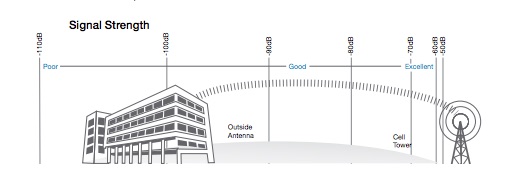CHAPTER
1
How cellphone signal works
Cellphone signal is what connects one user to another across networks. Signal reaches a cellphone to facilitate communication in essentially the same manner that two-way radios communicate – via a signal transmitter and a signal receiver.
When you are talking on a cellphone, it converts your voice into a signal that is transmitted via radio waves to the nearest cell tower. The cell tower then relays the radio wave back to the person you’re speaking to, converting it first to a signal and then back to sound again.
When cell signal is strong, that all happens seamlessly and users don’t give it a second thought. But sometimes cell signal is weaker, and that is when we experience dropped calls and stalled data transmissions.
RADIO WAVES EXPLAINED
Cellphones use radio waves to communicate. Radio waves transport digitized voice or data in the form of oscillating electric and magnetic fields, called the electromagnetic field (EMF). The rate of oscillation is called frequency. Radio waves carry the information and travel in air at the speed of light.
Cellphones transmit radio waves in all directions. The waves can be absorbed and reflected by surrounding objects before they reach the nearest cell tower. For example, when the phone is placed next to your head during a call, a significant portion (over half in many cases) of the emitted energy is absorbed into your head and body. In this event, much of the cellphone’s EMF energy is wasted and no longer available for communication.
CELL PHONE ANTENNAS EXPLAINED
Cell phones contain at least one radio antenna in order to transmit or receive radio signals. An antenna converts an electric signal to the radio wave (transmitter) and vice versa (receiver). Some cell phones use one antenna as the transmitter and receiver while others, such as the iPhone 5, have multiple transmitting or receiving antennas.
An antenna is a metallic element (such as copper) engineered to be a specific size and shape for transmitting and receiving specific frequencies of radio waves. While older generation cell phones have external or extractable antennas, modern cell phones contain more compact antennas inside the device thanks to advanced antenna technologies. It’s important to understand that any metallic components in the device (such as the circuit board and the metal frame) can interact with the transmission antenna(s) and contribute to the pattern of the transmitted signal.
Many modern smart phones also contain more than one type of antenna. In addition to the cellular antenna, they may also have Wi-Fi, Bluetooth and/or GPS antennas.
CONNECTIVITY EXPLAINED
As mentioned earlier, a cell phone is a two-way wireless communication device and needs both the inbound signal (reception) and the outbound signal (transmission) to work. The magnitude of the received signal from the cell tower is called the “signal strength”, which is commonly indicated by the “bars” on your phone.
The connectivity between a cell phone and its cellular network depends on both signals and is affected by many factors, such as the distance between the phone and the nearest cell tower, the number of impediments between them and the wireless technology (e.g. GSM vs. CDMA). A poor reception (fewer bars) normally indicates a long distance and/or much signal interruption between the cell phone and the cell tower.
In order to conserve battery life, a cell phone will vary the strength of its transmitted signal and use only the minimum necessary to communicate with the nearest cell tower. When your cell phone has poor connectivity, it transmits a stronger signal in order to connect to the tower, and as a result your battery drains faster. That’s why good connectivity not only reduces dropped calls, but also saves battery life.
CHAPTER
2
Main causes of bad cell signal
There are three main causes of signal problems: distance from the cell tower, obstacles in the way like buildings; mountains or local obstructions, and the construction material of your home or office building. These issues can also work together to compound the problem.
1. Distance from the Cell Tower:
Cellular signal is broadcasted from towers that are installed by local operators (Vodacom, MTN, Cell C, Telkom.). The closer you are to a tower, the stronger the cell signal is going to be. As you move further away from the tower, the signal becomes weaker, which we call attenuation, until at some point it’s too weak to hold a call or transfer data.
Being too far away from a cell tower is the most common reason for weak cell signal, and the one you’ll often experience if you live or travel in very rural areas.
2. Obstacles in the Way:
The second cause of poor or erratic cell signal is the presence of obstacles between you and the nearest cell tower, like a mountain, hill, or building. You may also experience cell signal problems if you’re at the bottom of a valley or underground and don’t have line of sight to a nearby tower.
Signal is not usually able to penetrate through large obstacles. The cell signal may bounce off of other hills or buildings and reach you through reflection, in which case you’ll notice that your signal is weaker and may fluctuate up & down, otherwise you’ll most likely end up with no signal in your location.
3. Building Materials:
That last major cause of cellular signal problems is the construction materials that make up the building that you’re in. Brick, block, concrete, sheet metal and wire mesh construction materials are some well-known and obvious blockers of cell service, but things like energy efficient window coatings, tile or metal roofs, and water fixtures can also cause major signal issues.
If you find that you have a usable cell signal outside of the building, but it drops significantly once you step inside, then construction materials are the most likely culprit. Here is a list of the most common materials to look out for:
Combination of factors:
Unfortunately, these causes of bad cell signal frequently work in combination. For example, a rural warehouse with weak outside signal and sheet metal walls that completely block the signal from entering the building, or a house in a valley without a clear line of sight to the nearest cell tower, and no other nearby cell towers from which to receive a signal.
When looking at solutions to solve your cellphone signal problem, it’s good to have an idea of what combination of causes is creating the problem in the first, so that the right solution can be put into place.

CHAPTER
3
How a repeater system can help
A cellphone signal booster [also known as cellular repeater or a cell signal amplifier] is an ICASA-certified and network-approved system (MTN, Vodacom, Telkom, Rain, Cell C) that improves your weak 2G, 3G & 4G LTE cell coverage.
A cellphone signal booster kit / repeater system is a system made up of an outside antenna, a cellphone signal amplifier, one or more inside antennas, and cable to connect them all together.
The outside antenna receives cellular signal from the nearby cell towers and passes it over a cable to the signal amplifier. The signal amplifier boosts the strength of the signal, and then passes it over another cable to the inside antenna (or multiple antennas), which broadcast the strong cell signal to the area that needs it.
The signal booster also works in reverse, so when a phone call is made or data is used by a mobile device, it passes through the system, is amplified, and then broadcast to the nearby cell towers.
A cell phone signal booster is designed to solve the three main causes of poor cell phone signal in the following ways:
1. Distance from the Cell Tower:
The signal booster amplifies the weak outside cell signal, both to and from the nearby cell towers, to compensate for the distance.
2. Obstacles in the Way:
An omni outside antenna can receive and broadcast strong cell signal in all directions to maximize the chance that the signal will make it around the obstacles in the way.
3. Construction Materials:
The signal booster uses high quality cable to route cell signal around the construction materials that are blocking signal and then distribute it to the areas that need better reception.
As long as you have some usable cell signal outside, a cell phone signal booster / repeater system should be able to solve your signal problems and provide you with much better service in your home or office.

